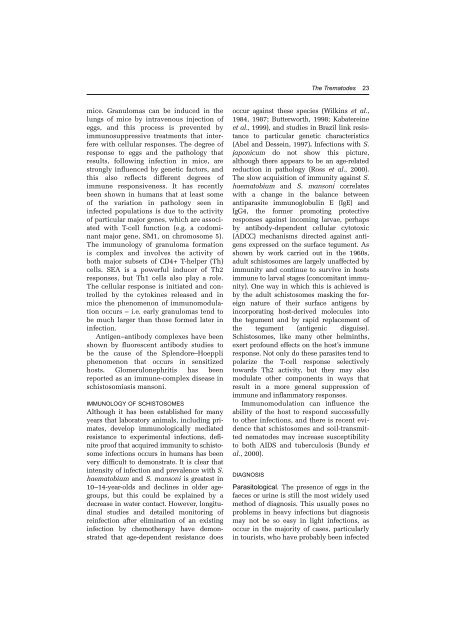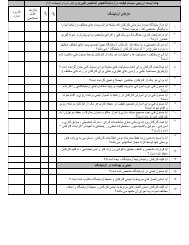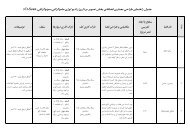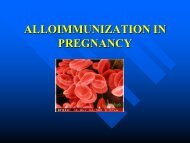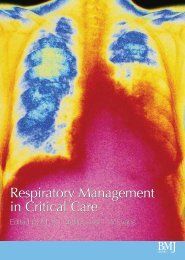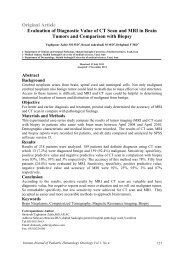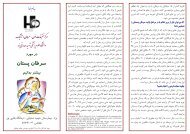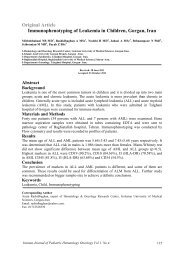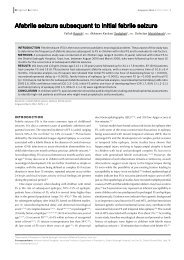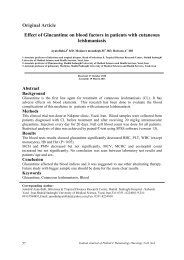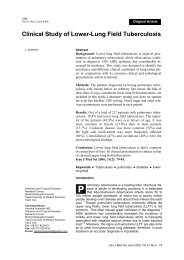You also want an ePaper? Increase the reach of your titles
YUMPU automatically turns print PDFs into web optimized ePapers that Google loves.
mice. Granulomas can be induced in the<br />
lungs of mice by intravenous injection of<br />
eggs, <strong>and</strong> this process is prevented by<br />
immunosuppressive treatments that interfere<br />
with cellular responses. The degree of<br />
response to eggs <strong>and</strong> the pathology that<br />
results, following infection in mice, are<br />
strongly influenced by genetic factors, <strong>and</strong><br />
this also reflects different degrees of<br />
immune responsiveness. It has recently<br />
been shown in humans that at least some<br />
of the variation in pathology seen in<br />
infected populations is due to the activity<br />
of particular major genes, which are associated<br />
with T-cell function (e.g. a codominant<br />
major gene, SM1, on chromosome 5).<br />
The immunology of granuloma formation<br />
is complex <strong>and</strong> involves the activity of<br />
both major subsets of CD4+ T-helper (Th)<br />
cells. SEA is a powerful inducer of Th2<br />
responses, but Th1 cells also play a role.<br />
The cellular response is initiated <strong>and</strong> controlled<br />
by the cytokines released <strong>and</strong> in<br />
mice the phenomenon of immunomodulation<br />
occurs – i.e. early granulomas tend to<br />
be much larger than those formed later in<br />
infection.<br />
Antigen–antibody complexes have been<br />
shown by fluorescent antibody studies to<br />
be the cause of the Splendore–Hoeppli<br />
phenomenon that occurs in sensitized<br />
hosts. Glomerulonephritis has been<br />
reported as an immune-complex disease in<br />
schistosomiasis mansoni.<br />
IMMUNOLOGY OF SCHISTOSOMES<br />
Although it has been established for many<br />
years that laboratory animals, including primates,<br />
develop immunologically mediated<br />
resistance to experimental infections, definite<br />
proof that acquired immunity to schistosome<br />
infections occurs in humans has been<br />
very difficult to demonstrate. It is clear that<br />
intensity of infection <strong>and</strong> prevalence with S.<br />
haematobium <strong>and</strong> S. mansoni is greatest in<br />
10–14-year-olds <strong>and</strong> declines in older agegroups,<br />
but this could be explained by a<br />
decrease in water contact. However, longitudinal<br />
studies <strong>and</strong> detailed monitoring of<br />
reinfection after elimination of an existing<br />
infection by chemotherapy have demonstrated<br />
that age-dependent resistance does<br />
occur against these species (Wilkins et al.,<br />
1984, 1987; Butterworth, 1998; Kabatereine<br />
et al., 1999), <strong>and</strong> studies in Brazil link resistance<br />
to particular genetic characteristics<br />
(Abel <strong>and</strong> Dessein, 1997). Infections with S.<br />
japonicum do not show this picture,<br />
although there appears to be an age-related<br />
reduction in pathology (Ross et al., 2000).<br />
The slow acquisition of immunity against S.<br />
haematobium <strong>and</strong> S. mansoni correlates<br />
with a change in the balance between<br />
antiparasite immunoglobulin E (IgE) <strong>and</strong><br />
IgG4, the former promoting protective<br />
responses against incoming larvae, perhaps<br />
by antibody-dependent cellular cytotoxic<br />
(ADCC) mechanisms directed against antigens<br />
expressed on the surface tegument. As<br />
shown by work carried out in the 1960s,<br />
adult schistosomes are largely unaffected by<br />
immunity <strong>and</strong> continue to survive in hosts<br />
immune to larval stages (concomitant immunity).<br />
One way in which this is achieved is<br />
by the adult schistosomes masking the foreign<br />
nature of their surface antigens by<br />
incorporating host-derived molecules into<br />
the tegument <strong>and</strong> by rapid replacement of<br />
the tegument (antigenic disguise).<br />
Schistosomes, like many other helminths,<br />
exert profound effects on the host’s immune<br />
response. Not only do these parasites tend to<br />
polarize the T-cell response selectively<br />
towards Th2 activity, but they may also<br />
modulate other components in ways that<br />
result in a more general suppression of<br />
immune <strong>and</strong> inflammatory responses.<br />
Immunomodulation can influence the<br />
ability of the host to respond successfully<br />
to other infections, <strong>and</strong> there is recent evidence<br />
that schistosomes <strong>and</strong> soil-transmitted<br />
nematodes may increase susceptibility<br />
to both AIDS <strong>and</strong> tuberculosis (Bundy et<br />
al., 2000).<br />
DIAGNOSIS<br />
The Trematodes 23<br />
Parasitological. The presence of eggs in the<br />
faeces or urine is still the most widely used<br />
method of diagnosis. This usually poses no<br />
problems in heavy infections but diagnosis<br />
may not be so easy in light infections, as<br />
occur in the majority of cases, particularly<br />
in tourists, who have probably been infected


